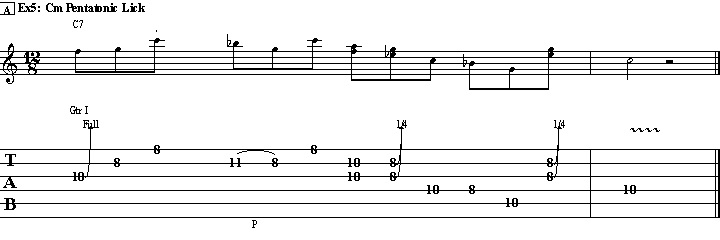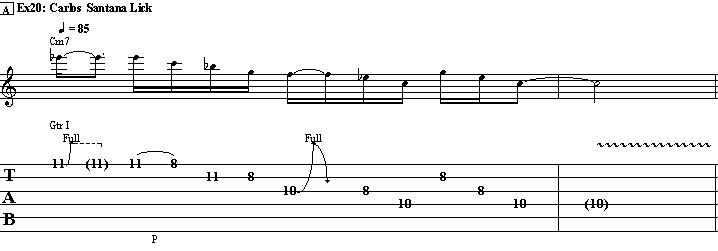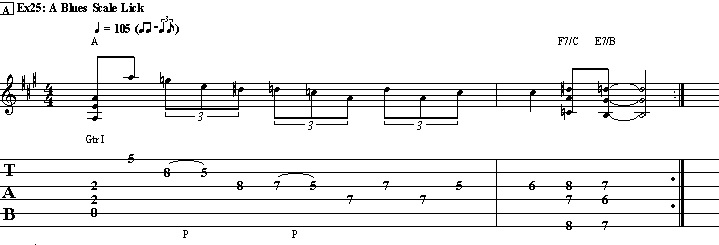
25 “Must Know” Blues Licks For Beginners
Blues is one of the most popular forms of music, specifically for guitar players! It originated in the southern USA by African Americans around the turn of the 19th century.
In this course we will learn how to play some of the most important blues licks for the beginner lead guitarist.
So before we jump into the licks, we will learn a few basic scales of which the licks will be
based in.
There’s a few main scales that are used for playing the blues: These include the minor pentatonic scale, the major pentatonic scale, and the so-called “blues scale”.
Let’s start with the minor pentatonic scale in A.
THE SCALES
Ex1: A minor pentatonic (5 notes) scale

Ex2: This is the major pentatonic scale in A

Ex3: Another crucial resource in blues lead playing is to mix up both minor and major pentatonic scales to create a new scale. Check it out:

Ex4: The “minor blues scale” is the most used one. It’s basically a minor pentatonic scale with the addition of the “blue” note. This is a flat 5th or sharp 4th.

Ex5: The last one we will learn is the Dorian scale or mode. This is a diatonic (7 note) minor scale with a major 6th.

THE LICKS
Ok, now let’s jump to the licks.
So let’s start from the most basic to the most complex ones.
Ex1: This is an easy lick with the C pentatonic minor scale. It works over Cm7 or C7. That’s a very unique approach in blues music. You can play a minor scale over a major or dominant 7th chord or vice versa.

Ex2: This is another C pentatonic minor scale lick with some cool bends. Bending is one of the main techniques in blues lead playing. Try this lick over Cm7 or C7.

Ex3: This one is a variation from the previous example. The first part is longer and it ends in a similar way.

Ex4: This is a pretty common blues lick with the C minor pentatonic scale.

Ex5: This is another blues lick with the C minor pentatonic scale with the addition of double stops. That’s a commonly used technique in blues lead playing which consists of usually playing two strings at the same time.

Ex6: This is a variation from the previous lick with more double stops.

Ex7: This one is like the “ABC” in blues soloing, especially the beginning. It uses the C minor pentatonic scale with the addition of a major 3rd. So this idea belongs to the mixed up pentatonic scale group.

Ex8: This is a classic blues lick with the C minor blues scale over a C7 chord. You can play it over a Cm, Cm7 or even a C chord.

Ex9: This is another little idea with the A minor blues scale which is based in a repetitive motion.

Ex10: This is a similar idea from the previous lick which adds another note.

Ex11: This is another variation with the A minor blues scale.

Ex12: Here’s a little lick with the A minor blues scale. Sometimes learning little ideas is better to be able to incorporate into our playing.

Ex13: This is a more complex lick since we are playing a longer idea passing throughout almost the entire scale.

Ex14: This is an interesting A minor blues scale lick which uses the second scale shape.

Ex15: This is an easy lick with the A minor pentatonic scale.

Ex16: This one is a little bit more complex with the A minor blues scale plus some chromaticism, which sounds jazzy.

Ex17: This idea uses the A Dorian scale and it starts with an F note which doesn’t belong to that scale. So we can look at it as a passing note. Passing notes are usually in the up beats.

Ex18: This is a cool idea in A mixing up different scales, like major and minor pentatonic plus a major 6th (F#) which belongs to the Dorian scale. It also has some string skipping.

Ex19: Here’s another lick mixing up scales and a passing note (F).

Ex20: This is a cool lick by the great Carlos Santana from his classic song “Europa”. It uses the C minor pentatonic scale with the addition of a C minor arpeggios.

Ex21: This a cool little lick with the A Dorian scale with some chromatic or passing notes.

Ex22: This another interesting lick starting with an A major arpeggio continuing with passing notes.

Ex23: This is another lick with arpeggios. It’s in C but it starts on the 4th chord which is F, so it starts with the arpeggio of F7.

Ex24: Here’s another lick in A mixing up scales and a new passing note, a major 7th (G#). It also starts with a little A major arpeggio.

Ex25: So this is the last lick. It’s a cool idea in A with the minor blues scale and it could work perfectly for ending a blues song.

Alright, hope you like the licks and you can incorporate them in your own playing. So once you learn them, start experimenting and try to come up with new ideas.
Have a great blues practice time!
Cheers,
Silvio.
About The Author
